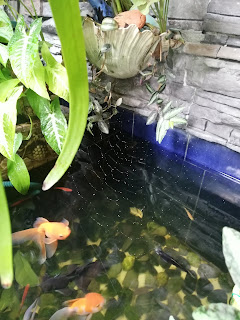You might find a common Asystasia which normally have a showy flower but often found as wild roadside plants and considered as a weed plant. And so in comparison this appear to be strangely so different from the original counter-part particularly this one where it is very much cultivated for the variegated foliage (which have yellow tones)
Also Asystasia is considered invasive commonly known as Chinese Violet, Coromandel, Ganges Primrose & Creeping Foxglove - those are mostly cultivated for the floral ornament plant where the foliage has white colorations (the floral variegated version)
This one however rarely flowers.
Characteristics:
This one have fine skeleton like creeping vine which can prove fragile and may suddenly die away if they are not strongly rooted. However, roots do appear at each nodes when they touch ground surface making them more resilient and hardy. Watering is important as they do not do well as drought tolerant plant - they just wither away within a day and it would be too late to regenerate them.
And so, always have spare plant - trimmed and pruned and stashed somewhere - it may suddenly punish you when they suddenly die without warning when you miss their watering regime: such an unforgiving plant.
However once they pick up their growing regime they can appear to full in a bush. And so pruning is required to keep them in shape or else they can be unruly and may break and fall apart in their own weight as they grow overlapping each other.
MEDIUM:
They can do well with regular potting mix - do place them more on the drier side, fast draining medium as they can also rot easily when over-watered.
WATERING:
Daily watering and twice a day on a hot day. They can wither and dry away - and so to keep a tab on them as they may not recover once they had passed withering stage.
LIGHT:
They thrive on bright shaded area - which is very ideal for them as a basket hanging plants. Also do well as ground creeping plant.
PRUNING:
As I mentioned earlier - pruning is mandatory as they can appear to be leggy, messy and out of shape.
Other than that, it is basically an easy going plant when you find a nice suitable spot for it.
There are also few different varieties that I had seen sold in the nurseries as they appear in the plant market during festive seasons.




































































